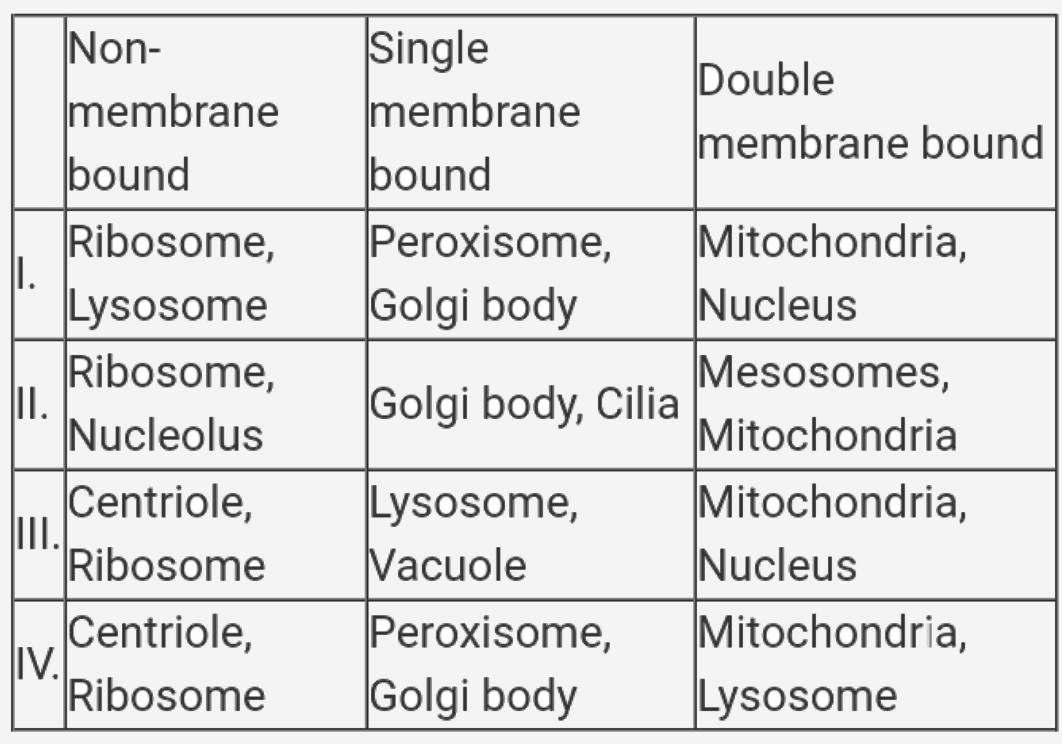What are cell organelles?
Step-by-Step Solution:
1. Definition of Cell Organelles:
- Cell organelles are specialized structures found within a cell. They are distinct entities that perform specific functions necessary for the cell's operation and survival.
2. Characteristics of Cell Organelles:
- Each organelle has a unique structure and function. They are essential for various cellular processes and contribute to the overall functioning of the cell.
3. Examples of Cell Organelles:
- Some common examples of cell organelles include:
- Mitochondria: Known as the powerhouse of the cell, they generate energy in the form of ATP.
- Golgi Apparatus: Involved in modifying, sorting, and packaging proteins and lipids for secretion or delivery to other organelles.
- Ribosomes: Sites of protein synthesis, where amino acids are assembled into proteins.
- Endoplasmic Reticulum (ER): A network of membranes involved in protein and lipid synthesis. It comes in two forms: rough (with ribosomes) and smooth (without ribosomes).
- Lysosomes: Contain enzymes that digest waste materials and cellular debris.
4. Functionality:
- The organelles work together to ensure the cell functions properly, maintaining homeostasis and responding to environmental changes.
- Cell organelles are specialized structures found within a cell. They are distinct entities that perform specific functions necessary for the cell's operation and survival.
- Each organelle has a unique structure and function. They are essential for various cellular processes and contribute to the overall functioning of the cell.
- Some common examples of cell organelles include:
- Mitochondria: Known as the powerhouse of the cell, they generate energy in the form of ATP.
- Golgi Apparatus: Involved in modifying, sorting, and packaging proteins and lipids for secretion or delivery to other organelles.
- Ribosomes: Sites of protein synthesis, where amino acids are assembled into proteins.
- Endoplasmic Reticulum (ER): A network of membranes involved in protein and lipid synthesis. It comes in two forms: rough (with ribosomes) and smooth (without ribosomes).
- Lysosomes: Contain enzymes that digest waste materials and cellular debris.
- The organelles work together to ensure the cell functions properly, maintaining homeostasis and responding to environmental changes.
Topper's Solved these Questions
- CELL : THE UNIT OF LIFE BOOK - MODERN PUBLICATIONCHAPTER - CELL : THE UNIT OF LIFE EXERCISE - NCERT FILE (NCERT EXERCISE QUESTIONS)
14 Videos
- CELL : THE UNIT OF LIFE BOOK - MODERN PUBLICATIONCHAPTER - CELL : THE UNIT OF LIFE EXERCISE - NCERT FILE (NCERT EXEMPLAR PROBLEM (A. MULTIPLE CHOICE QUESTIONS))
14 Videos
- BREATHING AND EXCHANGE OF GASESBOOK - MODERN PUBLICATIONCHAPTER - BREATHING AND EXCHANGE OF GASESEXERCISE - CHAPTER PRACTICE TEST
14 Videos
- CELL CYCLE AND CELL DIVISIONBOOK - MODERN PUBLICATIONCHAPTER - CELL CYCLE AND CELL DIVISIONEXERCISE - CHAPTER PRACTICR TEST (SECTION-D)(LONG ANSWER TYPE QUESTION)
1 Video
Similar Questions
Knowledge Check
Which cell organelle helps in keeping the cell clean by digesting any external matter and bad cell organelles?
AGolgi ApparatusBMitochondriaCPlastitsDLysosomeIdentify the cell organelles present only in animals cells
ANucleusBCentrosomesCPlastidsDLysosomesAssertion- Chloroplast is a cell organelle.
Reason- An organelle is a distinct part of a cell, which has a particular structure and function.ABoth assertion and Reason are true and reason is the correct explanation of assertionBBoth assertion and reason are true, but reason is not the correct explanation of assertionCAssertion is true, but reason is falseDAssertion is false, but reason is true

